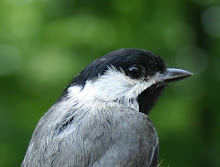As my closest friends and readers know, I love
cacti. While the primary goal of our trip to Arizona was for birdwatching, I was looking forward to being among my cacti friends. I fell in love with the Saguaros (pronounced s-WAR- oh.) in Tucson. They were everywhere; out in the desert, on hillsides, roadsides, and in neighborhoods (although I imagine they were landscaped in). I know I am anthropomorphizing when I say this, but they were like a
community of silent sentinels, guarding over their little spot in the
desert.
Saguaro
(Carnegiea gigantea) is the largest cactus in the United States.
This plant can live 150 - 200 years, but will not be mature enough to bloom until they are at least 30 - 40 years old. To say saguaro is a slow growing plant is somewhat of an understatement. But growth rate is linked to yearly rainfall. In the Tucson Mountains, located just west of Tucson, the annual rainfall averages 14 inches, a saguaro takes about 10 years to attain 1¼ - ½ inches in height and 30 years to reach 2 feet. Saguaros begin to flower
at about 8 feet tall, which takes about 55 years. The saguaros found in Saguaro National Park, located in Tucson, only take 40 years to bloom. The rainfall in that National Park averages 16 inches each year. The Organ Pipe Cactus National Monument in Ajo, Arizona, receives only 9 inches of annual rainfall and takes 75 years for the Saguaro to bloom. But when all is said and done growing, a saguaro will reach 40 - 60 feet in height.

A saguaro can produce up to 40 million
seeds, but as with all forms of organic life, it is only considered successful if one plant grows to replace its parent. The saguaro creates white flowers on top in the spring with peak bloom time being mid-May through mid-June. Nighttime blooming, the strong fragrance emitted during the twilight hours and the copious amounts of pollen and nectar produced make the saguaro flowers especially enticing to bats. In fact, bats are the primary pollinators and seed dispersers of the saguaro. The flowers bear fruit during the summer months, up to 2000 seeds per fruit, and White-winged Doves, rodents, javelinas, and
coyotes eat the fruit and distribute the seed.
A seedling requires summer rain in order to sprout followed by 2 - 3 years of seasonal rain to survive. These tiny cacti usually grow under a canopy of plants that shelters them from the elements and hides them from foraging rodents, rabbits and birds. Saguaro in general cannot tolerate more than a day of freezing temperatures and will not grow in regions that receive less than 2 inches of summer rain. This explains why a "forest" of saguaro appear to all be the same size. Some scientists believe that a good crop of saguaro may only come a few times in the time span of 100 years.

During a year of good rainfall, an adult saguaro can weigh 3200 - 4800 pounds. Ribs, located under the green, waxy exterior, can expand and contract depending on water intake. The main root (the tap root) will extend down over 2 feet. The plant's remaining roots are fairly close to the surface, 4 - 6 inches deep but will radiate out as far from the plant as it is tall. During a rainy season, the saguaro will send out new roots, known as rain roots, and collect as much water as possible.
As with the rest of the plant, the arms of a saguaro are slow growing, taking at least 5 years to grow 6 inches. The arms store water, provide extra surface area for photosynthesis, and acts as a good nesting place for some bird species, especially cactus wrens.
 |
| Cactus wren between the 2 arms that are in front. |
 |
| Closeup of a Cactus Wren nest. |
The bulky part of the saguaro protects the plant from extreme temperatures. The heat absorbed during the day is stored within the interior tissue and radiates the heat out slowly during the night. This also protects the plant during the rare times the temperatures drop to freezing during the night. What an amazing plant. How could someone not love the saguaro?
This is the last of my Arizona entries, but stay tuned; I will be headed to Seattle and Nome Alaska in a few weeks.



















